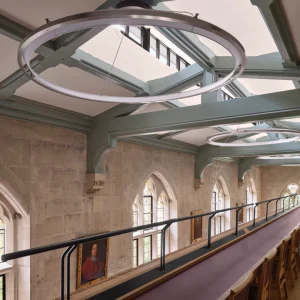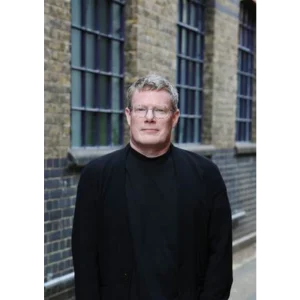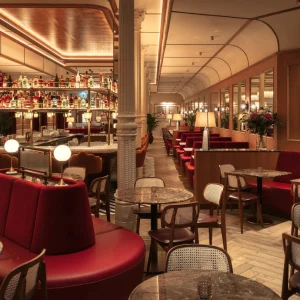Words by Pamela Buxton
What has your role been in relation to The Ministry?
I’m the creative director for the project. In simplistic terms, my role was to work out the creative strategy and oversee its execution.
Have you had experience as a design client before?
Several of the projects I’ve worked on for Ministry of Sound as a client have had an architecture/interiors focus. As well as collaborating with a range of British and international practices on the design of bars and clubs, we have worked on less obvious projects such as a hotel concept in collaboration with Thomas Heatherwick.
 Simon Moore. Portrait: Andrew G Hobbs
Simon Moore. Portrait: Andrew G Hobbs
What were your ambitions and priorities for the nature of The Ministry?
The initial motivation for the project came from a frustration at the dearth of good working environments for creative people. Many places say they’re designed for this market, but in reality they are the work of property or finance people who think that if you stick a ping-pong table in and put a load of motivational slogans on the wall then it’s job done.
We wanted to create the perfect place for creative people to work that allows members to base themselves in a range of different environments, is filled with facilities – we have a cinema, sound studios and an immersive tech suite – and puts social interaction at its heart, which was why we’ve incorporated a private members’ club into the lower two floors. Ministry of Sound wants to draw on what it’s learned from 27 years of experience within the creative industries to help the next generation of creative entrepreneurs to flourish.
What research did you do for the new venture – did you analyse other workplaces and members’ clubs, or did you look to other sectors for inspiration?
We did lots of research before formulating the brief and throughout the whole process. We had to be clear not just about what we wanted to do, but also what to avoid.
In London, most members’ clubs have the same vintage, slightly chintzy style, and shared workspaces are often bland soulless places trotting out the same modern office clichés. We wanted to do something new and fresh that felt like a real alternative to everything else out there.
In terms of other sectors, what we referenced most during the project were hotels. The way good hotels treat sleep as a pleasurable activity, rather than simply a function of life, and build a world around that was particularly influential. Our members have jobs they enjoy, not endure. A day at work for them is not the depressing slog that much office design implies and the lines between professional and social lives are increasingly blurred. We wanted therefore to create a space that reflects this – somewhere people can come and be happy, not just watch the clock tick down to 5.30.
I also set out to travel a lot and gather influence from places outside London. Much of the key design reference came from these visits, specifically Berlin where many venues take rawness to an extreme degree, but retain an elegance and beauty. The Boros Collection, an art gallery in a Second World War concrete bunker, was a particular inspiration.
 At the new Ministry work space, much of the furniture is custom-designed, as are the cushions and rugs. Image Credit: James Jones
At the new Ministry work space, much of the furniture is custom-designed, as are the cushions and rugs. Image Credit: James Jones
Did you look at many sites before choosing the former printworks? Why did you choose the site you did?
We were very lucky that this site was only the second one we looked at and is a two-minute walk from Ministry of Sound itself in Elephant & Castle, south London. It’s a six-storey Victorian building filled with character that was buried beneath a multitude of plasterboard partitions and synthetic carpets.
We realised early on that we wanted to strip everything right back and let the beauty of the building itself become the focal point around which everything else was created.
What brand values/ experience did you want to communicate, and how do these relate to the Ministry of Sound ‘mother brand’?
One of the key things we wanted to do was create a link back to Ministry of Sound, but in a much more fundamental way than simply sticking logos everywhere. So the very first thing we did was go back through the brand’s creative archive and pick out the key characteristics that ran through its best work.
We used these as the DNA for this new project. In doing so we effectively remixed Ministry of Sound for a new industry.
This work led us to identify the concept of [what is termed Premium Raw], which combines bold simplicity with a high-quality finish. Here that translates into a brutally stripped-back environment, exposing the raw fabric of the building, counterbalanced with elegant, simple furniture, plush textiles and well-considered details. The contrast of these two styles creates a powerful and distinctive aesthetic that’s true to the parent brand’s heritage but also feels very contemporary.
How do you go about choosing your designers?
Once we’d settled upon this creative direction we began looking around for the right designers to help us execute it. Having seen the work it did on its own offices [The Department Store in Brixton], we knew Squire & Partners were the right people. There was no pitch. We brought them in for a look at the site and were instantly impressed by their thoughtful response to the building and creative ideas.

What are the particular design challenges of creating such an environment?
Aside from creating something that stands out in a crowded market and has a stylistic link to the parent brand yet is relevant to a new sector, the main challenge was to produce a space that was filled with variation and difference, but felt consistent throughout.
We know that the way people work in this industry isn’t by being chained to a desk for eight hours. Instead, they require different environments for different tasks. We also wanted to avoid the soul-destroying monotony of repetition – coming into work day after day and being confronted by the same sights and choices.
The danger of this approach is that it would be easy to end up with a disjointed scheme. This was why having a clearly defined, but flexible, aesthetic strategy became so important in holding everything together.
What are the key features in Squire & Partners’ design for The Ministry?
Squire and Partners took our Premium Raw concept and translated it beautifully to the building. This is typified by the design of the 22m-long bar at the heart of the members’ club. We knew we wanted this to be a real statement feature, but not in an ostentatious way. It also couldn’t be too simple as, at this size, it could end up look like a squat, featureless block. The practice’s solution combines horizontally ranged copper pipes topped with a thick concrete slab – a nod back to the bar within Ministry of Sound itself. The contrast of the shiny, elegantly lit metal with the raw concrete perfectly encapsulates the aesthetic we were looking for.
Have you enjoyed the creative collaboration with Squire & Partners?
Hugely so. Aside from its creative skills and friendly, helpful manner, its attention to detail was what really stuck with me. I normally irritate the hell out of those I work with about this, so it was a real pleasure to work with people who take such pride in the details and understand their importance. I have nothing but the highest praise for Tim Gledstone, Maria Cheung and the team.
What were the most challenging and rewarding parts of working as a design client of The Ministry?
We made the decision quite early on that we didn’t want to rely on a superficial approach to creating a new brand. Instead of a logo-centric proposition relating to Ministry of Sound, we delved deeper into how we could create something people feel was unique without having to bludgeon them with logos and fonts.
With that in mind, a large proportion of the furniture is bespoke designed, as are aspects like rugs, cushions and staff uniforms. We’ve also introduced specially commissioned, subtle soundscaping to the building by electronic music legend Tom Middleton, and created our own room fragrance which fills the transitory areas with a unique scent.
We then ensured the building is completely unbranded (in the traditional sense). This allows our members to have more ownership of the space without being suffocated by an imposed, third-party, identity scheme.
All of this was a hugely challenging and time-consuming approach, but the result is a deeper, more personal and highly sensory solution to creating a brand, and one that is ultimately more satisfying to see come to life.
Do you expect to be commissioning designers for any further projects and if so, what and when?
The Ministry is already proving to be very successful, so we are discussing future sites. The prospect of developing what we’ve already done and applying our ethos to new places is something that, as a team, we are very excited about.





